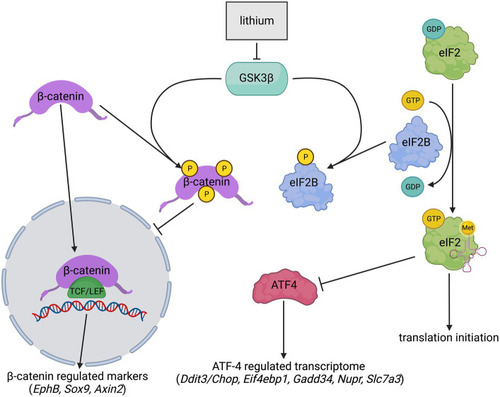- Title
-
Lithium: effects in animal models of vanishing white matter are not promising
- Authors
- Witkamp, D., Oudejans, E., Hoogterp, L., Hu-A-Ng, G.V., Glaittli, K.A., Stevenson, T.J., Huijsmans, M., Abbink, T.E.M., van der Knaap, M.S., Bonkowsky, J.L.
- Source
- Full text @ Front. Neurosci.
|
Simplified schematic overview of lithium effects on GSK3β, eIF2B, and β-catenin. Lithium inhibits GSK3β activity. GSK3β inhibition lowers eIF2B phosphorylation (yellow) levels resulting in increased eIF2B activity and presumably downregulated expression of ATF4 and the ATF4-regulated transcriptome. GSK3β inhibition also stabilizes β-catenin by impeding its phosphorylation (yellow) at Ser33, Ser37, and Thr41. Phosphorylated β-catenin is highly unstable and was therefore not quantified. Non-phosphorylated β-catenin moves to the nucleus and joins with a member of the T-cell factor/lymphoid enhancer factor (TCF/LEF) family of transcription factors. This joining upregulates the expression of several genes, including |
|
Lithium improves motor deficits in mutant PHENOTYPE:
|
|
Lithium induces more pronounced polydipsia in WT than in |
|
Lithium does not increase the expression and activity of non-phosphorylated β-catenin. WT (circles) and |
|
Lithium subtly increases the expression of the ATF4-regulated transcriptome in the mouse brain. WT (circles) and |





